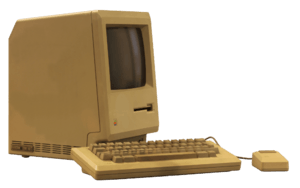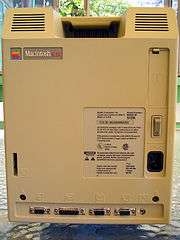Macintosh 512K
 | |
| Also known as | M0001W |
|---|---|
| Release date | September 10, 1984 |
| Introductory price | US$2,795 (equivalent to $6,377 in 2015) |
| Discontinued | April 14, 1986 |
| Operating system | 1.0, 1.1, 2.0, 2.1, 3.0, 3.2,[1] 3.3, 3.4, 4.0, 4.1 |
| CPU | Motorola 68000 @ 7.8338 MHz (Effectively 6 MHz) |
| Memory | 512 kB RAM (built-in) |
| Predecessor | Macintosh 128K |
| Successor |
Macintosh 512Ke Macintosh Plus |

The Macintosh 512K Personal Computer is the second of a long line of Apple Macintosh computers, and was the first update to the original Macintosh 128K. It was virtually identical to the previous Mac, differing primarily in the amount of built-in memory (RAM).
History
Soon after Apple introduced the Macintosh 128K they realized that the Macintosh would need more internal memory. Eight months later, on September 10, 1984, Apple introduced the Macintosh 512K. With quadrupled RAM, the Macintosh was able to become a more business-capable computer and gained the ability to run more software. The Mac 512K originally shipped with Macintosh System 1.1 but was able to run Macintosh System 1.0 all the way up to System 4.1. When the Macintosh Plus was introduced in 1986, the Macintosh 512K was discontinued on April 14, 1986. All support for the Mac 512K was discontinued on September 1, 1998.
Features
Processor and memory
Like the 128K Macintosh before it, the 512K contained a Motorola 68000 connected to a 512 kB DRAM by a 16-bit data bus. Though the memory had been quadrupled, it could not be upgraded. This large increase earned it the nickname Fat Mac. A 64 kB ROM chip boosts the effective memory to 576 kB, but this is offset by the display's 22 kB framebuffer, which is shared with the DMA video controller. This shared arrangement reduces CPU performance by up to 35%. It shared a revised logic board with the re-badged Macintosh 128K (previously just called the Macintosh), which streamlined manufacturing. The resolution of the display was the same, at 512x342.
Software
The applications MacPaint and MacWrite were still bundled with the Mac. Soon after this model was released, several other applications became available, including MacDraw, MacProject, Macintosh Pascal and others. In particular, Microsoft Excel, which was written specifically for the Macintosh, required a minimum of 512 kB of RAM, but solidified the Macintosh as a serious business computer. Models with the enhanced ROM also supported Apple's Switcher, allowing cooperative multitasking among (necessarily few) applications.
New uses
The LaserWriter printer became available shortly after the 512K's introduction, as well as the number pad, mic, tablet, keyboard, mouse, basic mouse, and much more. It utilized Apple's built-in networking scheme LocalTalk which allows sharing of devices among several users. The 512K was the first Macintosh capable of supporting Apple's AppleShare built-in file sharing network, when introduced in 1987. The expanded memory in the 512K allowed it to better handle large word-processing documents and take better use of the graphical user interface and generally increased speed over the 128K model.
System software
The original 512K could accept Macintosh system software up to version 4.1; System Software 5 was possible if used with the Hard Disk 20; With the OEM 800 kB Drive and ROM upgrade kit a 512Ke could accept up to System 6.0.8.
Upgrades

An updated version replaced the Mac 512K and debuted as the Macintosh 512K enhanced in April 1986. It differed from the original 512K in that it had an 800 kB floppy disk drive[2] and the same improved ROM as the Macintosh Plus. With the exception of the new model number (M0001E), they were otherwise cosmetically identical. The stock 512K could also use an 800 kB floppy disk drive as well as the Hard Disk 20, the first hard disk manufactured by Apple exclusively for use with the 512K, but required a special system file (not required by the 512Ke) that loaded the improved ROM code into RAM, thus reducing the available RAM for other uses. Apple offered an upgrade kit which replaced the floppy disk drive and ROMs essentially turning it into a 512Ke. One further OEM upgrade replaced the logicboard and the rear case entirely with that of the Macintosh Plus.[3]
As with the original Macintosh, the 512K was designed with no slots for upgrade boards and had no hard-disk controller, so the few internal upgrades that were available for the 512K, such as General Computer's US$2,795 Hyperdrive hard drive, had to plug directly into the 68000 processor socket.[4] Other such upgrades included "snap-on" SCSI cards and RAM upgrades of 2 MB or more.
Timeline of compact Macintosh models

See also
References
- ↑ System Software: Configs for Mac 128K, XL, 512, & 512KE (7/94)
- ↑ Apple Inc. (August 22, 1991). "Double-Density Versus High-Density Disks". Article ID: 3802. Apple Inc. Retrieved June 28, 2008. "This article gives the specifications for the 800K floppy disks and the 1.44 MB floppy disks." 800K Disk has 1600 sectors and 1.44 MB Disk has 2880 sectors. A sector is 512 bytes.
- ↑ Macintosh Plus: Description (Discontinued) The Macintosh Plus Logic Board Kit
- ↑ Pournelle, Jerry (March 1985). "On the Road: Hackercon and COMDEX". BYTE. p. 313. Retrieved 19 March 2016.